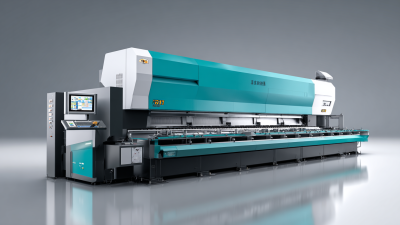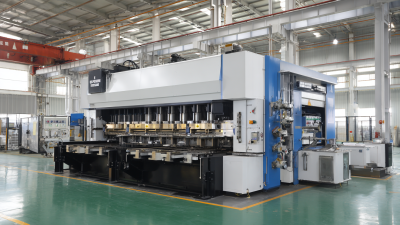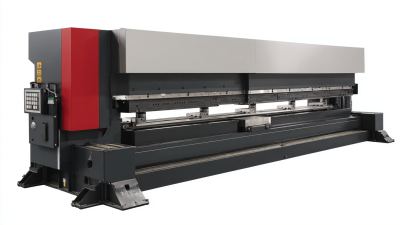Maximizing Precision and Efficiency in Fabrication with Advanced Sheet Metal Press Brake Technology
In the dynamic landscape of modern manufacturing, maximizing precision and efficiency in fabrication processes is paramount, particularly in industries reliant on sheet metal components. The sheet metal press brake stands out as a critical tool in achieving these objectives. Recent insights from industry reports indicate that the global sheet metal fabrication market is projected to reach USD 152.59 billion by 2027, growing at a CAGR of 4.8% from 2020. This growth underscores the increasing importance of advanced pressing techniques in enhancing the quality and speed of production. By leveraging cutting-edge sheet metal press brake technology, manufacturers can gain significant advantages, including reduced material waste, improved dimensional accuracy, and optimized labor costs. This "How to" guide aims to provide actionable strategies and best practices for integrating advanced press brake solutions into the fabrication workflow, ensuring that businesses remain competitive in an ever-evolving market.

Understanding Advanced Press Brake Technology for Enhanced Fabrication
Advanced press brake technology plays a crucial role in enhancing fabrication processes, significantly impacting precision and efficiency. Recent industry reports indicate that the global market for press brakes is projected to reach over $5 billion by 2025, growing at a CAGR of 4.8% from 2020 to 2025. This growth can be attributed to advancements in automation and control systems, enabling manufacturers to achieve tighter tolerances and higher production rates. For instance, modern CNC press brakes allow for real-time adjustments and monitoring, which minimize material waste and improve the overall quality of bend accuracy.
In addition to improved precision, advanced press brake technology is also revolutionizing efficiency within the fabrication sector. Studies show that utilizing software-integrated press brakes can enhance operational efficiency by up to 30%. Such systems leverage features like automated angle measurement and load sensing, ensuring that every bend meets the design specifications without manual intervention. This shift not only reduces labor costs but also accelerates turnaround times, making it imperative for manufacturers to adopt these technologies to remain competitive in a rapidly evolving market.
Key Features to Look for in a Modern Sheet Metal Press Brake
When selecting a modern sheet metal press brake, several key features significantly enhance precision and efficiency in fabrication. First, look for advanced control systems that incorporate CNC technology. These systems allow for precise adjustments and programming, enabling operators to execute complex bends with repeatable accuracy. The integration of software solutions can also facilitate real-time monitoring and error correction, which is crucial for maintaining high-quality standards throughout the production process.
Another important feature to consider is the machine's tooling versatility. A press brake with interchangeable tooling and adaptive bending capabilities can accommodate various material thicknesses and shapes, making it a valuable asset for workshops that deal with diverse projects. Additionally, hydraulic systems with adjustable pressure settings offer better control over the bending process, further ensuring that the desired results are achieved without compromising the integrity of the metal. Ultimately, investing in a press brake with these advanced features will lead to improved operational efficiency and a higher quality of finished products.
Techniques for Achieving Precision in Metal Bending Processes
 Achieving precision in metal bending processes is critical for enhancing the overall quality of fabricated products. Advanced sheet metal press brake technology has revolutionized the way manufacturers approach bending tasks. By integrating state-of-the-art software systems and automated machinery, operators can fine-tune settings with remarkable accuracy, minimizing errors and improving repeatability. This technological advancement allows for precise control over factors such as angle, depth, and material flow, ensuring that each bend meets exact specifications.
Achieving precision in metal bending processes is critical for enhancing the overall quality of fabricated products. Advanced sheet metal press brake technology has revolutionized the way manufacturers approach bending tasks. By integrating state-of-the-art software systems and automated machinery, operators can fine-tune settings with remarkable accuracy, minimizing errors and improving repeatability. This technological advancement allows for precise control over factors such as angle, depth, and material flow, ensuring that each bend meets exact specifications.
One technique pivotal to maximizing precision is the utilization of advanced tooling systems. These systems often employ interchangeable dies and punches designed to handle various thicknesses and materials, reducing setup times and allowing for quick adjustments. Additionally, employing real-time feedback mechanisms—such as laser measuring and sensors—enhances the ability to monitor the bending process continuously. By addressing deviations immediately, manufacturers can maintain tight tolerances and uphold product standards, leading to more efficient production cycles and a superior end product.
Best Practices for Maximizing Efficiency in Fabrication Workflows
In the world of fabrication, efficiency is key to maximizing productivity and minimizing waste. Implementing advanced sheet metal press brake technology allows manufacturers to streamline their workflows significantly. By integrating automation and precise control systems, fabricators can enhance accuracy while reducing cycle times, ensuring that each bend and cut meets the specified standards without the need for extensive rework.

Tips: To further enhance efficiency, consider adopting a lean manufacturing approach. This involves regularly reviewing and refining your fabrication processes to eliminate unnecessary steps and optimize resource allocation. Additionally, investing in operator training can lead to a more skilled workforce capable of operating advanced machinery effectively, directly impacting production quality and speed.
Another best practice is to implement software solutions for production planning and scheduling. These programs can help manage workloads, anticipate delays, and allocate resources effectively, ensuring that every piece of sheet metal is processed in the most efficient manner possible. Keeping equipment well-maintained also plays a critical role; regular inspections and timely repairs can prevent unexpected downtimes and enhance overall operational efficiency.
Troubleshooting Common Issues in Press Brake Operations for Optimal Results
In the realm of sheet metal fabrication, maximizing efficiency and precision with press brake operations is crucial. However, several common issues can hinder optimal performance. According to a report by the Fabricators and Manufacturers Association, nearly 30% of manufacturing downtime is attributed to equipment malfunctions and operator errors in press brake operations. Addressing these issues proactively can significantly reduce delays and improve production outcomes.
One frequent challenge is the misalignment of tooling, which can lead to inconsistent bends and wasted material. Regular maintenance and calibration, as highlighted in the 2022 "Press Brake Optimization Study" by the International Institute of Welding, show that facilities performing monthly tool checks see a 20% reduction in operational errors. Additionally, operator training plays an essential role; investing in comprehensive training programs can enhance workers' skills, reducing the likelihood of mistakes and improving overall efficiency. By troubleshooting these common issues and implementing systematic solutions, manufacturers can harness the full potential of advanced press brake technology, ensuring a smoother workflow and better quality results.
Maximizing Precision and Efficiency in Fabrication with Advanced Sheet Metal Press Brake Technology - Troubleshooting Common Issues in Press Brake Operations for Optimal Results
| Issue | Possible Causes | Solutions | Impact on Results |
|---|---|---|---|
| Inaccurate Bending Angles | Incorrect tooling setup, machine calibration issues | Recalibrate machine, ensure proper tooling installation | Leads to rework and material waste |
| Surface Scratches | Dirty tools, improper handling of sheets | Regularly clean tools, implement better material handling | Affects product aesthetics and quality |
| Sheet Deformation | Excessive force, incorrect die gap | Adjust die specifications, monitor force applied | Loss of dimensional accuracy |
| Tool Wear | Frequent use, inadequate maintenance | Establish regular maintenance schedule, inspect tools | Increases downtime and costs |
| Misalignment During Bending | Improper sheet loading, worn out aligners | Train operators on correct loading, replace worn parts | Results in inconsistent product dimensions |
Related Posts
-

Craftsmanship Redefined Chinese Manufacturing Delivering the Best Press Brake Solutions Worldwide
-

Discover the Excellence of China's Leading Factory for the Best Small Press Brake Solutions Worldwide
-

Ultimate Guide to Mastering Metal Press Brake Operations for Precision Fabrication
-

Unlocking Precision: The Best Press Brake Machines from China’s Premier Manufacturing Factory
-

Exploring the Future of Press Brake Machines at the 138th Canton Fair 2025: Industry Insights and Trends
-

Ultimate Guide to Choosing the Best Hydraulic Press Brake Machine for Your Needs
